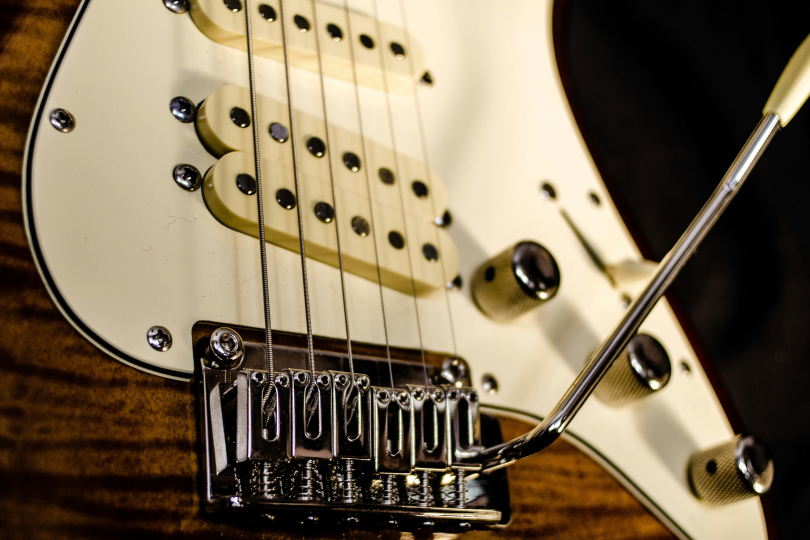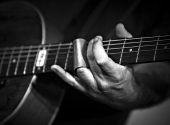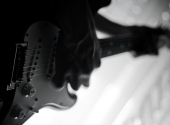
(Un)usual Guitar Techniques #5: Pickups and the Sound They Make
In today's part of our series we'll once again delve into guitar hardware which fundamentally affects the guitar sound. We'll take a look at the different types of pickups, their sonic characteristics and how to work with them in solos. We'll also look at how to get the most out of your guitar and how to solve the eternal dilemma – single coil or humbucker?
Just like the volume control, pickups are a great tool to modify the sound of your guitar right on the instrument. With some exaggeration, one could say that with the right fitting and wiring, you can have the sound of several completely different guitars in one instrument. If you own a collection of guitars and like to use them all at gigs, then this article may not appeal to you. But if, like me, you have "the one" that you swear by, you don't want to keep switching guitars when performing or, simply, cannot get more than one instrument, then working with pickups is a great way to have both a “Fender and a Gibson” in one guitar.
Single coil vs. humbucker
The guitar pickup is the "magical" place where the vibrations of the strings are transformed into an electrical signal, which is then sent to your amp. This makes it crucial to the character of your guitar's sound. What's more, you'll realise this when you record, this trait is rather definite at the output – while plug-ins, effects and instrument simulations can be changed in your DAW at will, if you record a solo on a single, you can't make it sound like a humbucker.
So let's quickly review the concepts. There are two basic types of pickups – single coil (SC, single) and two coil (HB, humbucker). Single coil pickups consist of a single coil – a series of magnets wrapped around with a copper wire, these are typically pickups on Fender Stratocaster, Telecaster, etc. They are especially loved by players of softer styles – indie, blues, country but also rock. Their minor drawback is that they produce hum, but they can also be found in a "noiseless" version. It also helps to use intermediate positions, i.e. simultaneous connection of e.g. a bridge and a middle pickup.
That is why humbuckers were developed – to suppress the hum (hence the name hum – bucker). They consist of a pair of single-coil pickups wound in opposite polarity. Their output signal is stronger. You'll typically find them on Gibson Les Paul and Flying V guitars. They are used by guitarists of harder styles – hard roc, and metal, but they are also popular in jazz.
There are other types of pickups, such as the P90, which is also a single-coil pickup, but is wider than typical narrow single-coils and produces a warmer, thicker sound.
What kind of sound are you going for today?
As mentioned, different types of pickups have very different sounds. Single coil pickups produce a bright clean sound with a distinctive treble that stands out especially well when clean or slightly distorted. Humbuckers, on the other hand, have a fuller, thicker sound that will support more pronounced distortion well.
However, the placement of the pickup on the guitar body also comes into play in equal measure. To give you an idea of the effect that pickup placement on a guitar has on the sound, think of a classical guitarist or playing an acoustic guitar. The closer to the fretboard you strum, the brighter, sharper and more "metallic" the tone will become. Conversely, if you play near the neck, you get a more middle, fuller tone. The same works with electric guitars and the difference is often very pronounced, which is why most electric guitars have at least two pickups.
So there is a sort of imaginary scale from the thickest sound from the humbucker mounted at the neck to the sharpest single coil sound at the bridge. Let's now take a look at how to use this range of sounds in solos. But let me share a little tweak with you first.
2-in-1 or Gibson or Fender?
If there are one or more humbuckers on your guitar, it's relatively easy to expand your sonic options by modifying their wiring so that both humbucker coils can be "split" and only one can be used – so-called a coil split. This gives you the extra sonic choices of a single pickup.
In case you don't want to interfere with the guitar body and drill another hole, the switching can be solved quite easily by inserting a push-pull potentiometer on the tone pot knob. It depends on your particular guitar and pickup configuration, of course, but especially if you want to have rather fewer but more versatile instruments, this little hack is definitely worth considering.
Unless you're an adventurer or DIY person, you're better off entrusting this to your favourite guitar maker. This way you will be sure that the pickups really work as you need them to and there will be no unexpected signal dropouts when you are standing on stage.
Solo for pickups
Switching pickups is a very subtle movement that often goes unnoticed when looking at a soloing guitarist. Yet many phenomenal guitarists work with pickups and switch them within a solo or even a single lick. If you watch the previous video and pay close attention to Ritchie's right hand, you'll see that he switches pickups for even a single note.
But is there any logic to switching pickups in solos? If we proceed from the scale of sonic possibilities offered by the type and setup of the pickup, we can simply say that when you play in low positions, it pays to use a single coil bridge pickup – it's higher in pitch, it cuts through the sound of the band better and there is no threat of making the solo sound "muddy". The higher up the fretboard you move, the sound is generally thinner and sharper; here, on the other hand, it's good to use humbuckers and the neck position of the pickup to make the sound round and add the required fullness.
Another possibility of using different types of sound is if you would like, for example, to achieve a dialogue effect and create the impression of matching phrases within a single solo. It is by alternating different pickups and their positions that the feeling of different voices is obtained. Similarly, you can highlight a particular phrase or tone in a solo. The important thing is to listen to how your guitar sounds within the whole piece. If the solo is drowned, it helps to switch to a pickup closer to the bridge. Conversely, if you think the sound is too harsh and "jars on the listener's ears," switch to pickups closer to the neck to make it softer.
Many guitarists, myself included, are fairly comfortable creatures, and when we find a sound that suits us, we often sort of stick with it. Until recently, I used to switch pickups rather rarely, and when I did, it was for an entire song. About a year ago, however, I had both humbuckers split and suddenly I had a classic SC-SC-SC Stratocaster configuration to go with my original HB-SC-HB setup.
I was surprised at how wide a range of amazing sounds I could suddenly get out of one guitar. This made me start thinking a lot more about what pickup to use for a specific type of playing and noticing how my favourite guitarists work with this.
How do you work with pickups? Do you prefer a single coil or a humbucker? Let us know in the comments!
If you have found an error or typo in the article, please let us know by e-mail info@insounder.org.





